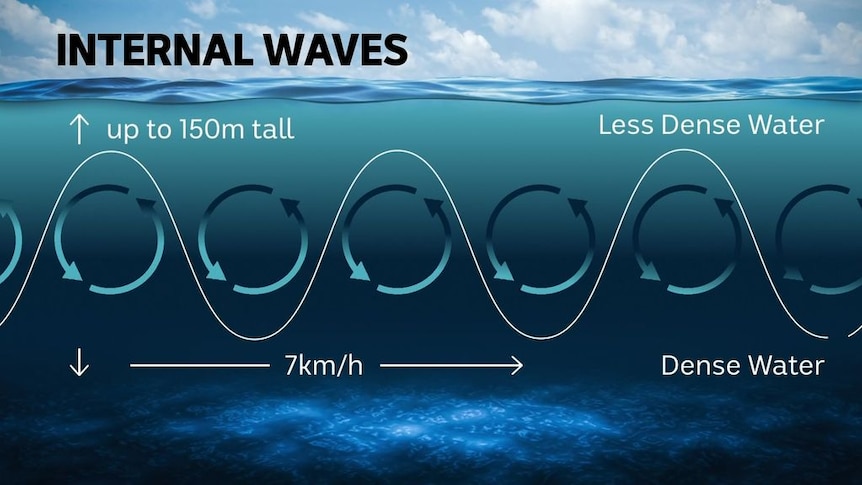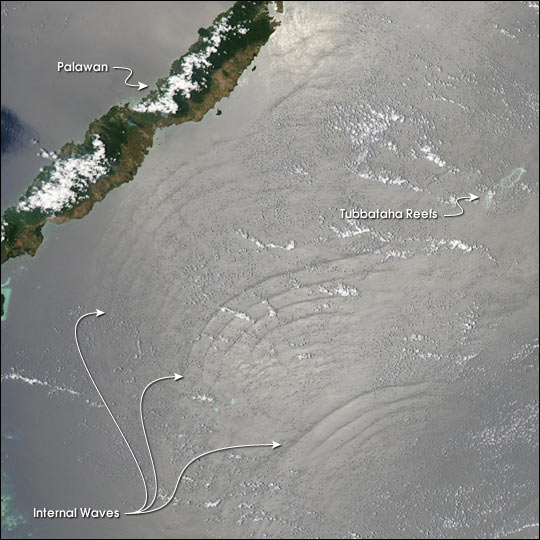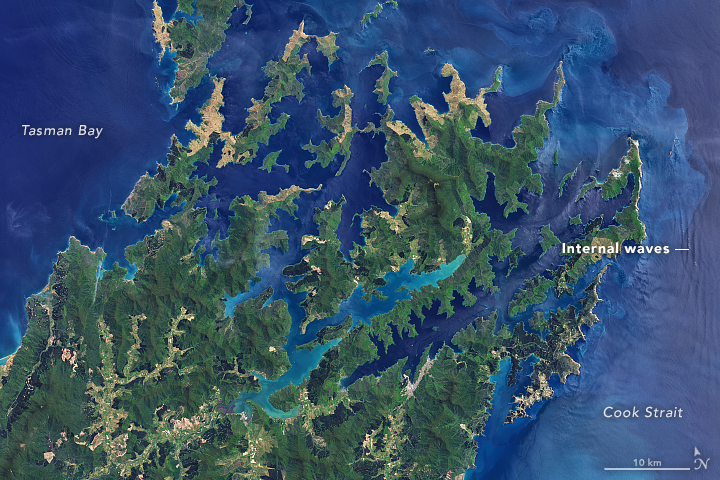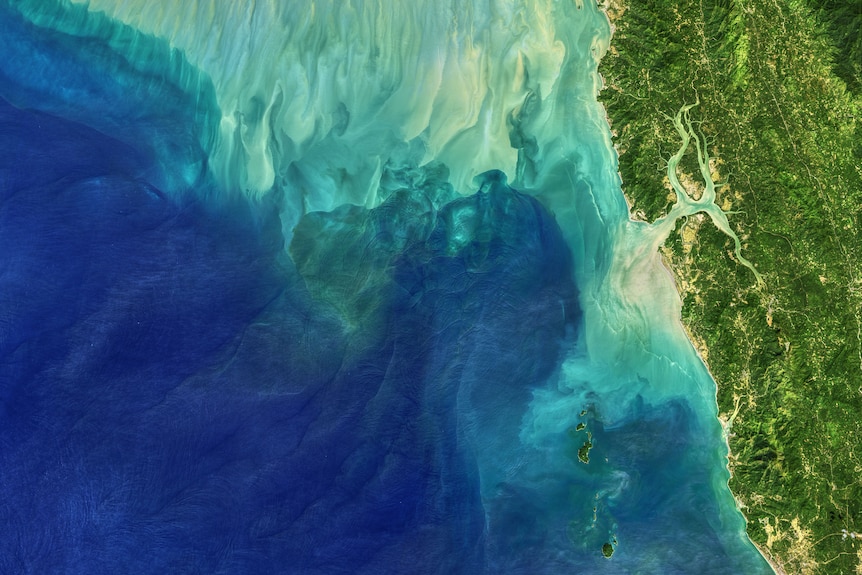What we know about the underwater waves that may have sunk Indonesia's sub
Posted 12h
 Indonesia's submarine may have been hit by powerful underwater wave event
Indonesia's submarine may have been hit by powerful underwater wave event
Share
Last week an Indonesian submarine cruised through the Lombok Strait between the islands of Bali and Lombok to carry out routine testing.
But in the early hours of April 21, the 44 year-old KRI Nanggala 402 submarine dropped out of contact and plummeted 838 metres to the ocean floor, taking 53 crew members with it.
Indonesian military officials found the sunken vessel broken into three parts on the bottom of the Bali Sea.
Hold on ... an internal solitary what?
The ocean is in a constant state of motion with the rise and fall of tides, currents and waves.
Waves don't just occur on the surface, they're also generated in deeper water.
This is because the density of the ocean changes from the surface to the bottom of the sea floor — the colder the water gets, the more dense it becomes.
But this change in density doesn't happen smoothly, says Stuart Corney, an oceanographer at the University of Tasmania's Institute for Marine and Antarctic Studies.
"It happens in steps," Dr Corney said.
"Near the surface of the ocean, you might have the same density, salinity and temperature, and then you get to a point where there's a step change in density."
This creates a boundary layer between light and heavy bodies of water.
 This image shows internal waves moving north-east towards Palawan Island in the Sulu Sea, between the Philippines and Malaysia.( Supplied: NASA/GSFC/Jacques Descloitres/MODIS Land Rapid Response Team )
This image shows internal waves moving north-east towards Palawan Island in the Sulu Sea, between the Philippines and Malaysia.( Supplied: NASA/GSFC/Jacques Descloitres/MODIS Land Rapid Response Team )
When tides pass over rocky ocean floors and other obstacles, they can disturb the interface between these layers of water.
These disturbances lead to the build-up of massive underwater waves.
How often do these waves happen?
Underwater waves are pretty common, but they occur more frequently in some parts of the world than others.
In the notoriously turbulent Lombok Strait, these powerful waves occur almost every two weeks.
Strong tidal currents, a rugged ocean floor, and water flowing from the Pacific Ocean into the Indian ocean are a recipe for generating internal solitary waves.
It also doesn't help that powerful tides must squeeze through the narrow passage of the Lombok Strait, which has a width of just 40 kilometres at its widest point.
"That water, from the surface to the bottom, has got to get through."
This can create a lot of instability between the surface and bottom of the water, similar to turbulence on a plane.
"This can move submarines up and down in the water," Dr Sloyan said.
Can they affect ships?
Ships may seem safe gliding on the surface of the ocean, but they have played a key role in our understanding of internal solitary waves.
 Internal waves are shown in a diagram to the north-east of New Zealand's South Island in 2017.( Supplied: NASA )
Internal waves are shown in a diagram to the north-east of New Zealand's South Island in 2017.( Supplied: NASA )
It turns out that these underwater waves are a driving force behind dead water, a phenomenon discovered two centuries ago by Norwegian oceanographer Fridtjof Nansen.
This causes ships to slow down in seemingly calm water and good weather conditions, similar to wading through a sticky substance.
Dead water occurs when relatively fresh water sits on top of saltier, denser water, leading to the build-up of internal solitary waves beneath the surface.
How can we plan for these waves?
 Internal waves, like these pictured in the Andaman Sea off the coast of Myanmar, can be hundreds of metres tall and tens to hundreds of kilometres long.( Supplied: NASA Earth Observatory )
Internal waves, like these pictured in the Andaman Sea off the coast of Myanmar, can be hundreds of metres tall and tens to hundreds of kilometres long.( Supplied: NASA Earth Observatory )
While predicting regular internal waves is easy enough, figuring out when larger and more destructive types might occur, particularly in choppy regions like the Lombok Strait, is tricky, Dr Corney said.
"It's like a weather forecast. We have an idea that it might rain tomorrow, but we don't have the ability to predict exactly when," he said.
"We don't spend much time in the ocean, so our understanding is pretty limited.
"There's plenty of work left to be done."
Posted 12h
Share
Last week an Indonesian submarine cruised through the Lombok Strait between the islands of Bali and Lombok to carry out routine testing.
But in the early hours of April 21, the 44 year-old KRI Nanggala 402 submarine dropped out of contact and plummeted 838 metres to the ocean floor, taking 53 crew members with it.
Indonesian military officials found the sunken vessel broken into three parts on the bottom of the Bali Sea.
Hold on ... an internal solitary what?
The ocean is in a constant state of motion with the rise and fall of tides, currents and waves.
Waves don't just occur on the surface, they're also generated in deeper water.
This is because the density of the ocean changes from the surface to the bottom of the sea floor — the colder the water gets, the more dense it becomes.
But this change in density doesn't happen smoothly, says Stuart Corney, an oceanographer at the University of Tasmania's Institute for Marine and Antarctic Studies.
"It happens in steps," Dr Corney said.
"Near the surface of the ocean, you might have the same density, salinity and temperature, and then you get to a point where there's a step change in density."
This creates a boundary layer between light and heavy bodies of water.
When tides pass over rocky ocean floors and other obstacles, they can disturb the interface between these layers of water.
These disturbances lead to the build-up of massive underwater waves.
How often do these waves happen?
Underwater waves are pretty common, but they occur more frequently in some parts of the world than others.
In the notoriously turbulent Lombok Strait, these powerful waves occur almost every two weeks.
Strong tidal currents, a rugged ocean floor, and water flowing from the Pacific Ocean into the Indian ocean are a recipe for generating internal solitary waves.
It also doesn't help that powerful tides must squeeze through the narrow passage of the Lombok Strait, which has a width of just 40 kilometres at its widest point.
"That water, from the surface to the bottom, has got to get through."
This can create a lot of instability between the surface and bottom of the water, similar to turbulence on a plane.
"This can move submarines up and down in the water," Dr Sloyan said.
Can they affect ships?
Ships may seem safe gliding on the surface of the ocean, but they have played a key role in our understanding of internal solitary waves.
It turns out that these underwater waves are a driving force behind dead water, a phenomenon discovered two centuries ago by Norwegian oceanographer Fridtjof Nansen.
This causes ships to slow down in seemingly calm water and good weather conditions, similar to wading through a sticky substance.
Dead water occurs when relatively fresh water sits on top of saltier, denser water, leading to the build-up of internal solitary waves beneath the surface.
How can we plan for these waves?
While predicting regular internal waves is easy enough, figuring out when larger and more destructive types might occur, particularly in choppy regions like the Lombok Strait, is tricky, Dr Corney said.
"It's like a weather forecast. We have an idea that it might rain tomorrow, but we don't have the ability to predict exactly when," he said.
"We don't spend much time in the ocean, so our understanding is pretty limited.
"There's plenty of work left to be done."
